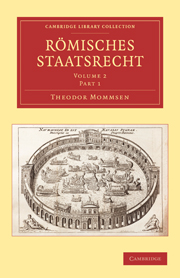Book contents
- Frontmatter
- Contents
- Das Königthum S. 3—15
- Die magistratische Befugniss des Oberpontifex S. 16—69
- Das Consulat S. 70—124
- Die Dictatur S. 125—153
- Das Reiterführeramt S. 156—164
- Der Consulartribunat S. 165—175
- Die Prätur S. 176—216
- Die Provinzialstatthalterschaft S. 217—246
- Der Volkstribunat S. 247—303
- Die Censur S. 304—442
- Die Aedilität S. 443—491
- Die Quästur S. 492—538
- Magistratische Offiziere S. 539—545
- Die magistratische Geschwornenleitung S. 546—555
- Der Vigintisex-, später Vigintivirat S. 556—571
- Ausserordentliche Beamte für die Reservatrechte der Gemeinde S. 572—600
- Ausserordentliche Aushülfsbeamte S. 601—637
- Die Senatsboten (legati) S. 638—661
- Die ausserordentlichen constituirenden Gewalten S. 662—697
Das Königthum S. 3—15
Published online by Cambridge University Press: 29 August 2010
- Frontmatter
- Contents
- Das Königthum S. 3—15
- Die magistratische Befugniss des Oberpontifex S. 16—69
- Das Consulat S. 70—124
- Die Dictatur S. 125—153
- Das Reiterführeramt S. 156—164
- Der Consulartribunat S. 165—175
- Die Prätur S. 176—216
- Die Provinzialstatthalterschaft S. 217—246
- Der Volkstribunat S. 247—303
- Die Censur S. 304—442
- Die Aedilität S. 443—491
- Die Quästur S. 492—538
- Magistratische Offiziere S. 539—545
- Die magistratische Geschwornenleitung S. 546—555
- Der Vigintisex-, später Vigintivirat S. 556—571
- Ausserordentliche Beamte für die Reservatrechte der Gemeinde S. 572—600
- Ausserordentliche Aushülfsbeamte S. 601—637
- Die Senatsboten (legati) S. 638—661
- Die ausserordentlichen constituirenden Gewalten S. 662—697
Summary
Dass die römische Gemeinde, wie überhaupt die italische, vom Königthum ausgegangen ist, bedarf keines Beweises; die Ordnung. spätere republikanische Verfassung will selber nichts sein als eine Modificirung dieses noch vielfältig daria erscheinenden oder doch durchscheinenden Königthums.
Von den Institutionen der historischen Zeit ftthren der, Opferkönig ‘(rex sarrorum S. 13) und der, Zwischenkönig ‘(interrex) nothwendig auf ein ursprüngliches Königthum.
Wenn das, Königshaus ‘(regia) an der heiligen Strasse noch den spätesten Geschlechtern das Andenken der Urzeit lebendig vor die Augen führte; wenn die Fasten des Numa das Fest der, Königsflucht ‘(regifugium) am 24. Februar verzeichnen, entsprechend der, Volksflucht‘, den poplifugia des 5. Mi, und wenn sie ram 24. März und 24. Mai bemerken: q(uando) r(e.r) c(omitiavit), f(as), so bezeichnen jener Name und diese Vermerke allerdings wohl zunächst die Amtswohnung und die religiösen Functionen der Könige der republikanischen Zeit, das ist eben des rex sncrormn; aber es kann keinem Zweifel unterliegen, dass sie ursprUnglich auf den wirklichen König sich bezogen haben.
Endlich geht die gesammte Ueberlieferung, und hier sicher nicht bloss aus gelehrtem Rückschluss, davon aus, dass urbem liomam a principle reges habuere und dass die Consuln erst zu herrschen begannen post reges exaclos. — Ueber das König-thum, und zwar das verfassungsmässig geordnete und mit den Patres und dem Populus in feste Beziehung gesetzte, führt die Betrachtung des römischen Gemeiuwesens nicht zurück, wie denn auch der annalistische Schematismus ganz angemessen nicht durch die Gemeinde den ersten König, sondern durch den ersten König die Gemeinde entstehen lässt.
- Type
- Chapter
- Information
- Römisches Staatsrecht , pp. 1 - 15Publisher: Cambridge University PressPrint publication year: 2010



